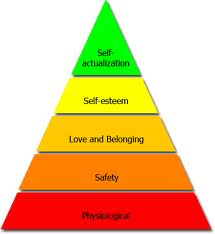Abraham Maslow’s Hierarchy of Needs
Abraham Maslow’s Hierarchy of Needs. The nature of initial studies on motivation can be summarised in the idea that “early and modern approaches to motivation are based on the premise that increasing the amount of time and effort that an individual devotes to a task (i.e. task motivation) will result in higher levels of individual performance and increased productivity for the organisation” (Landy and Conte, 2010, p.368).
Arguably the most prominent author on the topic of motivation is Abraham Maslow.
Maslow states (1943, p.372) that employees have five levels of needs:
1. The Physiological needs. This is the basic needs for living, which includes oxygen water, protein, salt, sugar, calcium, and other minerals and vitamins. They are also known as the “Biological necessities”. They also include the needs to be active, to rest, and to sleep. These needs are the strongest because a person needs to have the factors above in order to survive. In business environment it means good payment, and good environment for working.
2. The safety and security needs. When physiological needs are reached, the second need comes into place, which for employees means finding the safe circumstances, stability, and protection.
3. The belonging needs. When the both satisfactions are reached, belonging needs layer would arise. Employees might begin to feel the needs of friendships, affectionate relationships in general, or even a sense of community.
4. The esteem needs. Maslow has divided esteem needs into two parts: lower and higher self-esteem needs. The lower one is the need for respects for others, whereas the higher one requires self-respect, which includes the sense of confidence, achievement, independence, and freedom.
5. Self-actualization needs. This is the level, when employees satisfy all their needs, including the four needs above. In business sense it means the opportunities for developing new skills, scope to meet challenges and room to perform incentive and creativity.
The practical implications of Abraham Maslow’s Hierarchy of Needs in the workplaces are significant. Because being equipped with the theory managers would know that they would have to apply the immediate needs of their employees if managers would like to motivate them. In other words, the theory provides the knowledge that it is not effective it is not effective to apply to self-esteem of individuals with the purposes of motivating them, if that individual has issues at belonging, or even safety levels of needs.
Alderfer’s ERG theory (1972, p.221) reorganizes Maslow’s five human needs level into only three categories:
- Existence needs: material and physiological desires (Maslow’s first two levels)
- Relatedness needs: relationships with significant people and parties (Maslow’s third and fourth levels)
- Growth needs: self-esteem and self-actualization (Maslow’s third and fourth levels)
Skinner’s theory states (1953, p.170) if employees’ behaviors lead to positive outcomes they will be repeated and if behaviors lead to negative outcomes they will not be repeated. Thus, managers should positively reinforce employee behaviors that lead to positive outcomes and they should negatively reinforce employee behavior that leads to negative outcomes
References
- Alderfer, CP, 1972, “ Existence, Relatedness, and Growth; Human Needs in Organizational Settings”, New York: Free Press
- Maslow, AH, 1943, A theory of human motivation. Psychological Review, July 1943.
- Skinner, BF, 1953, “Science and Human Behavior” New York: Free Press.

